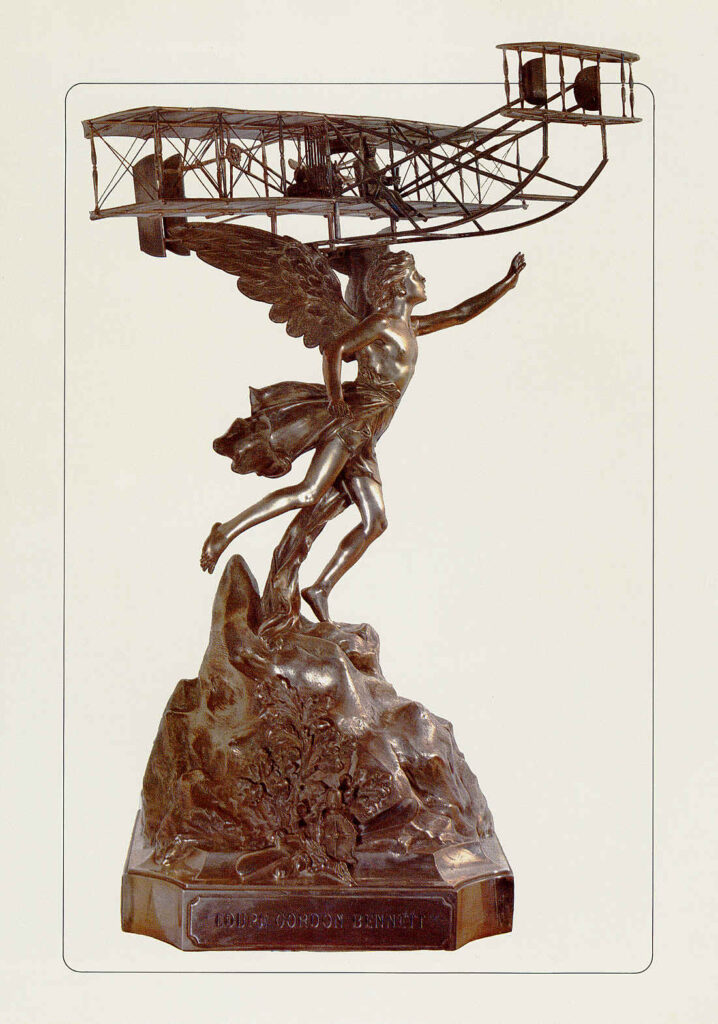Over the next month, we’ll be posting blogs about “The World’s Fastest Motor Sport.” The first of these posts will go into detail about the most popular air races and awards from the 1900s up to 1920, a time during which airplane technology continued to improve exponentially, thanks in no small part to the awards offered by many of the following air races’ sponsors.
1907-1925 – Daily Mail Aviation Prizes
Between 1907 and 1925, the Daily Mail newspaper would announce a cash prize for the first aviators to perform a particular task in aviation, or to the winner of an aviation race or event. These prizes are credited by many to have spearheaded the advancement of aviation during its early years, due to the cash prize being so highly sought after by early aviation pioneers. The Daily Mail aviation prizes led to the first cross-channel flight by Louis Blériot and the first non-stop transatlantic flight between North America and Ireland by Alcock and Brown.
1909-1920 – Gordon Bennett Trophy
The Gordon Bennett Trophy, presented between 1909 and 1920, was an international air racing trophy awarded by James Gordon Bennett, Jr., the owner and publisher of the New York Herald, at the time. Each year, the contest was hosted in the country that won the trophy the previous year. The award was postponed in 1913 due to World War I. In 1920, French pilot Joseph Sadi-Lecointe won for the third French victory in a row, granting France permanent possession of the trophy, therefore ending the event for good. The distance of the race increased every time due to the rapid improvement of aircraft performance at the time, from 12 miles in 1909 to 186 miles in 1920.
1912-1936 – Coupe Deutsch de la Meurthe
The Coupe Deutsch de la Meurthe was a speed trial with an award of 20,000 francs, plus a trophy valued at 10,000 francs for the first aviator to win three straight competitions. The 200-kilometer race was open to all powered aircraft. Winners would only be recognized if they surpassed the previous fastest lap by at least 10 percent. The 20,000-franc award would only be given if the best performance remained on top for eight months. Like many of the early air races, the Coupe Deutsch de la Meurthe was suspended during World War I. After World War I, the rules changed, allowing the next winner to keep the award permanently if his record remained for eight months. In August of 1920, French pilot Joseph Sadi-Lecointe became the holder of the Coupe (and the Gordon Bennett Trophy) after his January performance remained unbeaten for eight months. The Coupe Deutsch de la Muerthe was resurrected in 1920, 1933, and for the last time in 1936, though the rules changed slightly on each occasion.
1913-1931 (1981-present) – Schneider Trophy
The Schneider Trophy was a trophy awarded to the winner of a seaplane/flying boat race between 1913 and 1931, which was later revived in 1981 and still takes place today. Like the Gordon Bennett Trophy, the Schneider Trophy was hosted in the country that won the previous year. One of the most well known winners of the Schneider Trophy was American WWI and WWII veteran James “Jimmy” Doolittle in 1925, whose most famous flight was the Doolittle Raid in 1942, which you can read about here. The British government withdrew support for the race in 1931, but the Royal Aero Club revived the name in 1981 for a handicapped* race between any propeller-driver landplanes capable of maintaining 100 mph in straight and level flight that weigh up to 12,500 lbs. The original Schneider Trophy is on display at the Science Museum in London. The current trophy, maintained by the Royal Aero Club, is a full-size replica.
*Handicapped racing uses a scoring system that attempts to put everybody’s aircraft on the same level in order to reward the best pilot, not the best plane.
1920-1949 – Pulitzer and National Air Races
The Pulitzer Trophy Races were a series of pylon and cross-country races that first took place at Mitchell Field in New York in 1920. The races were later renamed the National Air Races when they moved to Cleveland, then were renamed yet again when they moved to Reno in 1964 and dubbed the National Championship Air Races or the Reno Air Races. From 1920 to 1950, minus a five-year hiatus during WWII, the Pulitzer Air Races served as a proving ground and showcase for the science of aviation and the rapid growth of aircraft technology. In 1949, a pilot named Bill Odom lost control of his P-51 and crashed into a nearby house, killing himself and two people inside. The race was put on yet another hiatus, making a return in 1964 as the National Championship Air Races/Reno Air Races that are still in commission today.
[ulp id=’xkA7bnsbSMSAnwAm’]

